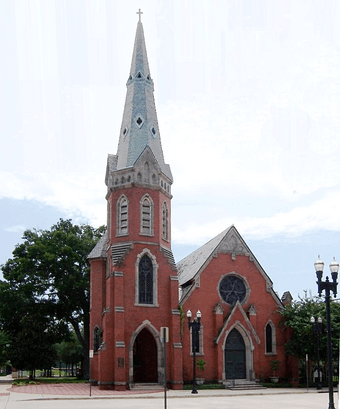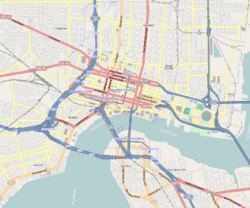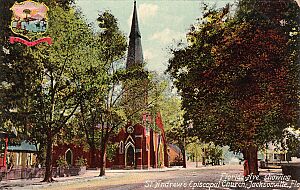Old St. Andrew's Episcopal Church facts for kids
Quick facts for kids |
|
|
St. Andrew's Episcopal Church
|
|

St. Andrew's Church building in 2008
|
|
| Location | 317 A. Philip Randolph Blvd., Jacksonville, Florida |
|---|---|
| Built | 1887 |
| Architect | Robert S. Schuyler |
| Architectural style | Late Gothic Revival |
| NRHP reference No. | 76000593 |
| Added to NRHP | May 4, 1976 |
The St. Andrew's Episcopal Church building, also known as Old St. Andrew's Event Venue, is a historic place in downtown Jacksonville, Florida. It is located at 317 A. Philip Randolph Boulevard. This building was once an Episcopal church.
The church closed in 1960 when its members moved to the suburbs. On May 4, 1976, the building was added to the U.S. National Register of Historic Places. This means it is a special place worth protecting. In the 1990s, the City of Jacksonville bought the building. They gave it to the Jacksonville Historical Society (JHS). Today, it is used for events and is managed by the society.
History of St. Andrew's Church
St. Andrew's Episcopal Church was designed by an architect named Robert S. Schuyler. He designed it in the Gothic Revival style. This style looks like old European churches and castles. Schuyler also designed other churches in Florida. These included churches in Fernandina, Waldo, and Pablo Beach.
The church was built in 1887. It was made from brick and had a large tower. The tower had a bell area and a tall, pointed roof. The building was praised in a book from 1889. People thought it was one of the most beautiful buildings in the South. The inside had wood from Florida pine trees. The doors were made of solid mahogany. The tower was 120 feet tall, making it the highest in the city at that time.
St. Andrew's was very strong. It was the only major church in Jacksonville that survived the Great Fire of 1901. This fire destroyed much of the city.
Changes in the Neighborhood
Starting with World War II, the area around the church changed a lot. Many factories and businesses moved in. Ships were built to help with the war. The Gator Bowl Stadium was built in 1949. The Mathews Bridge opened in 1953. Also, the Jacksonville Baseball Park began construction in 1954.
The neighborhood became very busy and noisy. Many people who lived there started to move away. They moved to new homes in the suburbs. Because of this, fewer people attended St. Andrew's Church. The church could no longer afford to stay open. In 1960, the church closed its doors. All its furniture and special items were moved to a new church.
Old St. Andrew's Episcopal Church was then closed and boarded up. It was empty for almost 30 years. The building became old and damaged. It was a big challenge to save this historic place. But things changed when the Jacksonville Jaguars NFL team came to the city. The City of Jacksonville bought land around the Jacksonville Municipal Stadium. This land included the Old St. Andrew's site.
Bringing the Church Back to Life
The City of Jacksonville gave the Jacksonville Historical Society the job of restoring the building. Many people thought the building was too damaged to be fixed. But the society worked hard to save it. They received a grant of $242,000 from the state of Florida in 1996. They also raised $1 million with help from the Weaver Foundation.
The restoration work began in 1996. It was finished on April 18, 1998. The building became the new home for the Jacksonville Historical Society. Today, Old St. Andrew's is seen as one of the best examples of 19th-century architecture in Duval County. It is a popular place for meetings, weddings, and other community events. For example, ESPN held a party there for Super Bowl XXXIX in 2005.




